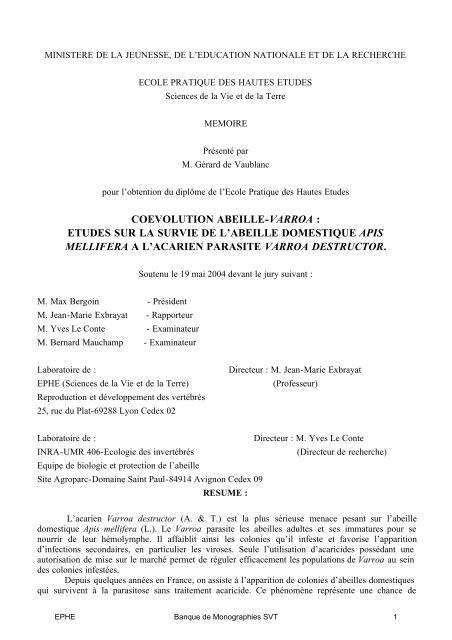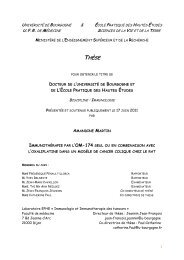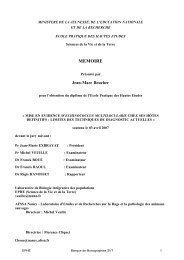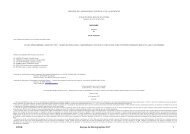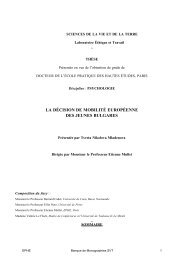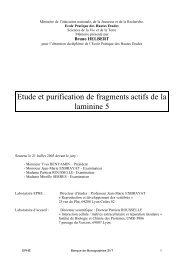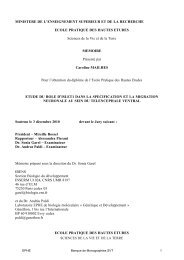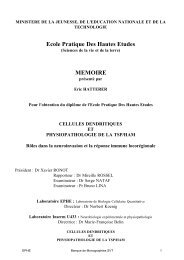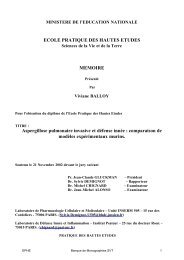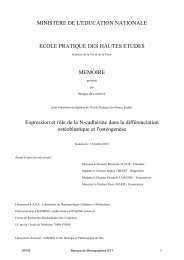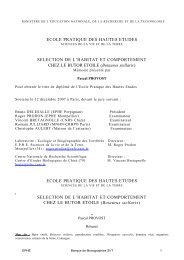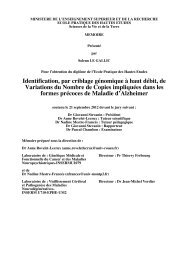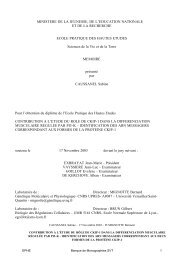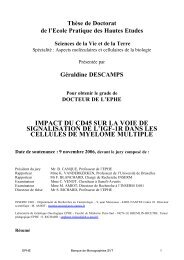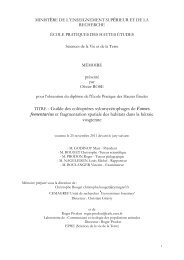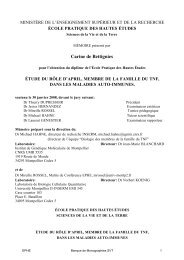coevolution abeille - EPHE
coevolution abeille - EPHE
coevolution abeille - EPHE
Create successful ePaper yourself
Turn your PDF publications into a flip-book with our unique Google optimized e-Paper software.
MINISTERE DE LA JEUNESSE, DE L’EDUCATION NATIONALE ET DE LA RECHERCHE<br />
ECOLE PRATIQUE DES HAUTES ETUDES<br />
Sciences de la Vie et de la Terre<br />
MEMOIRE<br />
Présenté par<br />
M. Gérard de Vaublanc<br />
pour l’obtention du diplôme de l’Ecole Pratique des Hautes Etudes<br />
COEVOLUTION ABEILLE-VARROA :<br />
ETUDES SUR LA SURVIE DE L’ABEILLE DOMESTIQUE APIS<br />
MELLIFERA A L’ACARIEN PARASITE VARROA DESTRUCTOR.<br />
M. Max Bergoin - Président<br />
M. Jean-Marie Exbrayat - Rapporteur<br />
M. Yves Le Conte - Examinateur<br />
M. Bernard Mauchamp - Examinateur<br />
Soutenu le 19 mai 2004 devant le jury suivant :<br />
Laboratoire de : Directeur : M. Jean-Marie Exbrayat<br />
<strong>EPHE</strong> (Sciences de la Vie et de la Terre) (Professeur)<br />
Reproduction et développement des vertébrés<br />
25, rue du Plat-69288 Lyon Cedex 02<br />
Laboratoire de : Directeur : M. Yves Le Conte<br />
INRA-UMR 406-Ecologie des invertébrés (Directeur de recherche)<br />
Equipe de biologie et protection de l’<strong>abeille</strong><br />
Site Agroparc-Domaine Saint Paul-84914 Avignon Cedex 09<br />
RESUME :<br />
L’acarien Varroa destructor (A. & T.) est la plus sérieuse menace pesant sur l’<strong>abeille</strong><br />
domestique Apis mellifera (L.). Le Varroa parasite les <strong>abeille</strong>s adultes et ses immatures pour se<br />
nourrir de leur hémolymphe. Il affaiblit ainsi les colonies qu’il infeste et favorise l’apparition<br />
d’infections secondaires, en particulier les viroses. Seule l’utilisation d’acaricides possédant une<br />
autorisation de mise sur le marché permet de réguler efficacement les populations de Varroa au sein<br />
des colonies infestées.<br />
Depuis quelques années en France, on assiste à l’apparition de colonies d’<strong>abeille</strong>s domestiques<br />
qui survivent à la parasitose sans traitement acaricide. Ce phénomène représente une chance de<br />
<strong>EPHE</strong> Banque de Monographies SVT 1
trouver une alternative aux acaricides qui ne sont pas sans conséquence pour les colonies et les<br />
produits de la ruche.<br />
Nous avons suivi la dynamique des populations de l’acarien au sein de colonies présumées résistantes<br />
et présumées sensibles à la varroase dans le but de caractériser cette survie et d’en trouver les causes.<br />
Les résultats nous montrent que les colonies non-traitées contre Varroa survivent pendant<br />
plusieurs années (de trois à neuf ans). Les causes de cette survie n’ont pas été clairement identifiées<br />
mais il semblerait que les colonies aient développé un comportement hygiénique dirigé contre<br />
Varroa, qui limiterait sa population de façon efficace.<br />
Nous avons aussi cherché à savoir si le phénomène d’infertilité jouait un rôle ou pas dans cette<br />
survie de nos <strong>abeille</strong>s à Varroa.<br />
Notre étude ne montre pas d’influence significative de l’infertilité sur la survie des <strong>abeille</strong>s au<br />
parasite mais de plus amples analyses sont à effectuer pour prouver cela de façon définitive.<br />
Des examens histologiques et histochimiques ont mis en évidence des sécrétions lipidiques<br />
dans la lumière de la glande séricigène de la larve d’<strong>abeille</strong>. Ce résultat permet de visualiser in situ ce<br />
que des études biochimiques antérieures ont montré : la présence de kairomones jouant un rôle<br />
essentiel dans les relations Abeille-Varroa.<br />
MOTS-CLES : Varroa destructor ; Apis mellifera ; dynamique des populations ;<br />
infertilité ; comportement hygiénique ; glande séricigène ; kairomones.<br />
GLOSSAIRE (* cf. texte)<br />
TABLE DES ILLUSTRATIONS<br />
TABLE DES MATIERES<br />
INTRODUCTION<br />
A) ETUDE BIBLIOGRAPHIQUE<br />
I. Cycle biologique de l’<strong>abeille</strong> du genre Apis<br />
II. Varroa jacobsoni parasite de l’<strong>abeille</strong><br />
A. Historique et répartition géographique<br />
B. Biologie du parasite<br />
1. Systématique<br />
2. Morphologie et cycle évolutif<br />
<strong>EPHE</strong> Banque de Monographies SVT 2
3. Le point sur les différentes espèces du genre Varroa<br />
4. Varroa et la colonie d’<strong>abeille</strong><br />
a. Cycle biologique du parasite<br />
b. Dynamique des populations de Varroa<br />
c. Recherche et choix de l’hôte<br />
d. Propagation de la parasitose<br />
e. Conséquence de la varroase sur l’<strong>abeille</strong><br />
f. Traitement de la varroase<br />
III. La résistance des <strong>abeille</strong>s au Varroa<br />
A. Le comportement d’épouillage des <strong>abeille</strong>s<br />
1. Chez Apis cerana<br />
2. Chez deux autres espèces d’<strong>abeille</strong>s<br />
B. Le comportement de nettoyage du couvain parasité<br />
1. Chez Apis cerana<br />
2. Chez Apis mellifera<br />
C. Effet de la durée d’operculation des alvéoles sur la reproduction de<br />
Varroa<br />
D. L’attractivité du couvain sur Varroa<br />
E. Le phénomène d’infertilité chez la femelle Varroa<br />
1. Chez Apis cerana<br />
2. Chez Apis mellifera<br />
3. Hypothèses et réponses sur les causes de l’infertilité de Varroa<br />
F. Effet de l’essaimage sur la dynamique des populations de Varroa<br />
IV. Varroa, et les virus de l’<strong>abeille</strong><br />
A. L’exemple de Varroa destructor<br />
B. Les virus principaux de l’<strong>abeille</strong> associés ou non à Varroa<br />
1. Les virus dont l’induction par Varroa est reconnue<br />
2. Les virus pathogènes de l’<strong>abeille</strong> avec ou sans Varroa<br />
3. Les virus sans association reconnue avec Varroa<br />
V. Un phénomène récent : La survie des colonies d’A. mellifera à Varroa<br />
destructor<br />
A. Le cas français<br />
B. Perspective de lutte<br />
B) OBJECTIFS DE MON TRAVAIL<br />
VI. Dynamique des populations de Varroa<br />
VII. Hypothèse sur la reproduction différentielle des Varroa élevés sur<br />
<strong>abeille</strong>s résistantes et sur <strong>abeille</strong>s dites sensibles<br />
VIII. Etude complémentaire sur l’histologie et l’histochimie de la larve<br />
d’<strong>abeille</strong><br />
C) MATERIELS & METHODES, RESULTATS & DISCUSSIONS<br />
<strong>EPHE</strong> Banque de Monographies SVT 3
IX. Evaluation de l’infestation de colonies « sensibles » et de colonies<br />
« résistantes » à l’acarien<br />
A. Introduction<br />
B. Matériels et méthodes<br />
1. Dynamique des populations de Varroa : estimation des chutes naturelles<br />
2. Dynamique des populations de Varroa : évaluation de l’infestation du<br />
couvain d’ouvrières et des <strong>abeille</strong>s adultes<br />
C. Résultats et discussion<br />
1. Survie des colonies étudiées<br />
2. Dynamique des populations de Varroa : estimation des chutes naturelles<br />
3. Dynamique des populations de Varroa : évaluation de l’infestation du<br />
couvain d’ouvrières et des <strong>abeille</strong>s adultes<br />
X. Elevage et infestation par Varroa destructor de larves d’A. mellifera en<br />
laboratoire<br />
A. Introduction<br />
B. Matériels et méthodes<br />
C. Résultats et discussion<br />
XI. Etude complémentaire : Histologie et histochimie de la glande séricigène<br />
chez la larve d’A. mellifera<br />
A. Introduction<br />
B. Matériels et méthodes<br />
C. Résultats et discussion<br />
1. Résultats<br />
2. Discussion<br />
D) CONCLUSION & PERSPECTIVES<br />
BIBLIOGRAPHIE<br />
ANNEXES<br />
<strong>EPHE</strong> Banque de Monographies SVT 4
INTRODUCTION<br />
L’apiculture mondiale est fondée sur l’exploitation de l’<strong>abeille</strong> mellifère européenne (Apis<br />
mellifera) qui est mise en danger par un véritable fléau, l’ectoparasite Varroa destructor. Cet acarien<br />
macroscopique, originaire d’Asie du sud, est le parasite naturel d’une autre espèce d’<strong>abeille</strong>, Apis<br />
cerana, et a trouvé récemment un nouvel hôte, Apis mellifera.<br />
Il a été observé pour la première fois sur Apis mellifera en 1948 en Thaïlande (Crane, 1979) et<br />
depuis s’est répandu rapidement dans le monde entier provoquant d’importants dégâts. En effet, les<br />
colonies d’<strong>abeille</strong>s mellifères européennes infestées s’effondrent, puis meurent en quelques années, si<br />
la population du parasite n’est pas régulée par l’apiculteur (Ritter, 1988). Des produits chimiques sont<br />
couramment utilisés pour lutter contre ce fléau mais ils peuvent remettre en cause la santé de l’<strong>abeille</strong><br />
et la qualité du miel issues de ces ruchers traités (Lodesani et al., 1992). De plus, la faible variété des<br />
molécules à propriété acaricide ayant une autorisation de mise sur le marché (AMM) favorise le<br />
phénomène de résistance des parasites à ces produits chimiques (Bassand, 1993).<br />
Une alternative aux traitements chimiques serait de promouvoir la résistance naturelle dont<br />
certaines colonies d’<strong>abeille</strong>s mellifères font preuve depuis quelques années. En effet, certaines<br />
colonies d’Apis mellifera infestées sont capables de survivre et même de continuer à se développer<br />
sans traitement acaricide. Les causes de cette survie à Varroa sont en cours d’identification.<br />
Cette acariose affecte la plupart des espèces, et sous espèces d’<strong>abeille</strong>s à travers le monde. Les<br />
deux espèces les plus étudiées sont A. cerana et A. mellifera. Apis cerana se distingue d’Apis<br />
mellifera pour la relation équilibrée qu’elle entretient avec l’acarien. La parasitose n’a donc pas<br />
d’effet létal sur les colonies de l’espèce A. cerana alors, qu’aujourd’hui encore, elle décime un grand<br />
nombre de colonies d’A. mellifera.<br />
Quel(s) mécanisme(s) permet(tent) à A. cerana de résister à ce parasite ? Pourquoi A. mellifera<br />
ne semble-t-elle pas capable de contrôler les populations de Varroa l’envahissant ? Comment cette<br />
résistance dont font preuve, à l’heure actuelle, des colonies d’A. mellifera, s’est-elle petit à petit mise<br />
en place au sein des ruchers ? Ces questions ont été traitées en partie seulement par les scientifiques.<br />
Leurs études préliminaires leur ont permis d’aboutir à la réponse suivante : A. mellifera et A. cerana<br />
présentent des mécanismes de résistances différents en intensité (Peng et al., 1987 ; Büchler, 1994 ;<br />
Boecking & Ritter, 1994 ; Boecking & Spivak, 1999).<br />
La relation hôte-parasite d’A. cerana et Varroa semble « équilibrée ». A. cerana a développé<br />
des comportements lui permettant de réguler efficacement la population du parasite, maintenant celleci<br />
à un seuil acceptable pour la survie de la colonie. En fait, les deux espèces ont certainement<br />
coévolué pour atteindre cet équilibre et cette coévolution résulte de leur durée de cohabitation (Peng<br />
et al., 1987 ; Rath & Drescher, 1990 ; Rath, 1991 ; Boecking & Ritter, 1994 ; Fries et al., 1996).<br />
<strong>EPHE</strong> Banque de Monographies SVT 5
La nouveauté de la relation hôte parasite d’A. mellifera et Varroa ne permet pas d’observer le<br />
même équilibre qu’avec A. cerana. En effet, A. mellifera présente une haute sensibilité à l’acarien et<br />
la croissance de la population du parasite n’est pas ou peu régulée par la colonie.<br />
Une autre <strong>abeille</strong>, croisement d’A. mellifera mellifera et d’A. mellifera scutellata (<strong>abeille</strong><br />
africaine) entretient une relation avec Varroa destructor constituant le stade de résistance<br />
intermédiaire. Ces <strong>abeille</strong>s, dites « africanisées », développent effectivement des mécanismes de<br />
résistance en général plus efficaces que chez les <strong>abeille</strong>s européennes non-africanisées (Moretto et al.,<br />
1991). La régulation de la population du parasite est incomplète mais permet, dans la plupart des cas,<br />
de limiter celle-ci à un seuil acceptable permettant la survie de la colonie.<br />
Les causes de ces phénomènes de résistance, plus ou moins développés selon les espèces et les<br />
races d’<strong>abeille</strong>s, se révèlent être multifactorielles (Büchler, 1994 ; Eischen, 1997a et b ; Boecking &<br />
Spivak, 1999 ; Rosenkranz,1999). Ceci explique la complexité et les différentes origines des<br />
comportements de résistances adoptées selon les espèces et les races d’<strong>abeille</strong>s.<br />
Cette résistance multifactorielle repose sur des stimuli dirigés vers l’<strong>abeille</strong> et/ou le parasite,<br />
d’ordre chimiques (kairomones*), physiques (actions mécaniques et température), physiologiques<br />
(durée de développement de l’<strong>abeille</strong>) et biologiques (virus).<br />
Comprendre ces mécanismes de résistance et évaluer leurs impacts sur la survie de la colonie<br />
d’<strong>abeille</strong>s et sur la dynamique des populations d’acariens est essentielle dans la mise en place d’un<br />
programme de lutte intégré utilisant ces facteurs contre Varroa.<br />
BIBLIOGRAPHIE<br />
Anglas J. (1901). Observations sur les métamorphoses internes de la guêpe et de l’<strong>abeille</strong>. Bull. Sci. France<br />
et Belgique, 34 : 363-473.<br />
Al-Ghzawi S. (1992). Das Eindringverhalten der Milbe Varroa jacobsoni. Apidologie, 23 (4): 369-370.<br />
Allen M. F. & Ball B. V. (1996). The incidence and world distribution of honey bee viruses. Bee World,<br />
77: 141-162.<br />
Allen M. F., Ball B. V., White B. V. & Antonin J. F. (1986). The detection of acute paralysis virus in<br />
Varroa jacobsoni by use of a simple indirect ELISA. J. Apic. Res., 25: 100-105.<br />
Anderson D. L. (1994). Non-reproduction of Varroa jacobsoni in Apis mellifera colonies in Papua New<br />
Guinea and Indonesia. Apidologie, 25: 412-421.<br />
Anderson D. L. (1996). Changed Varroa jacobsoni reproduction in Apis mellifera colonies in Java,<br />
Apidologie, 27: 461-466.<br />
Anderson D. L. & Sukarsih. (1996). Changed Varroa jacobsoni reproduction in Apis mellifera colonies in<br />
Java. Apidologie, 27 (6): 461-466.<br />
Anderson D. L. & Trueman J. W. H. (2000). Varroa jacobsoni (Acari : Varroidae) is more than one<br />
species. Exp. & Appl. Acarol., 24: 165-189.<br />
Athias-Binche F. (1990). Sur le concept de symbiose: l’exemple de la phorésie chez les acariens et son<br />
évolution vers le parasitisme ou le mutualisme. Bull. Soc. Zoo. Fr., 115: 77-98.<br />
Aumeier P. & Rosenkranz P. (1995). Welche faktoren der bienenlarven-kutikula beeinflussen die<br />
wirtsfindung der Varroa-Weibchen? Apidologie, 26 (4): 327-329.<br />
<strong>EPHE</strong> Banque de Monographies SVT 6
Bailey L. (1965). Paralysis of Honey Bee, Apis mellifera Linnaeus. J. Invert. Pathol., 7: 132-140.<br />
Bailey L. (1969). The multiplication and spread of sacbrood virus of bees. Ann. Appl. Biol., 63: 483-491.<br />
Bailey L. (1982). Viruses of honey bees. Bee World, 63: 165-173.<br />
Bailey L. & Ball B. V. (1991). Honey Bee Pathology, 2 nd edn. Academic Press, London, UK.<br />
Bailey L., Carpenter J. M. & Woods R. D. (1979). Egypt bee virus and Australian isolates of Kashmir bee<br />
virus. J. Gen. Virol., 43: 641-647.<br />
Bailey L. & Milne R. G. (1969). The Multiplication Regions and Interaction of Acute and Chronic Beeparalysis<br />
Viruses in Adult Honey Bees. J. Gen. Virol., 4: 9-14.<br />
Ball B. V. (1985). Acute Paralysis Virus isolates from honeybee colonies infested with Varroa jacobsoni. J.<br />
Apic. Res., 24(2): 115-119.<br />
Ball B. V. (1986). The incidence of acute paralysis virus in adult honeybee and mite populations. In:<br />
European research on varroatosis control. R. Cavalloro (eds). Proc. Meeting E. C. Experts’group,<br />
Udine (Italy), 28-30 november 1988. Luxembourg, Official Publications of the European<br />
Communities, 1989, pp. 241.<br />
Ball B. V. (1988). The impact of secondary infections in honey-bee colonies infested with the parasitic mite<br />
Varroa jacobsoni. In: Africanized Honey Bees and Bee Mites. Needham G. R. and Coworkers (eds),<br />
pp. 457-461.<br />
Ball B. V. (1997). Varroa and viruses. In: Varroa! Fight the mite, Munn P. & Jones R. (eds)., 11-15.<br />
Ball B. V. & Allen M. F. (1988). The prevalence of pathogens in honey bee (Apis mellifera) colonies<br />
infested with the parasitic mite Varroa jacobsoni. Ann. Appl. Biol. 113: 237-244.<br />
Ball B. & Bailey L. (1997). Viruses. In: Honey bee pests, predators & diseases. Morse R. A. & Flottum K.<br />
(eds). 11-32.<br />
Bassand D. (1993). Del buen o mal uso del fluvalinato contra Varroa: estudio de los riesgos de aparicion de<br />
resistencia. Vida Apic 61, 18-22.<br />
Beetsma J. & Zonneveld K. (1992). Observations on the initiation and stimulation of oviposition of the<br />
Varroa mite. Exp. & Appl. Acarol., 16: 303-312.<br />
Boecking O. & Drescher W. (1990). The reaction of worker bees in different Apis mellifera colonies to<br />
Varroa infested brood cells. Proc. Rec. Res. Bee. Pathol., Gent, Belgium: 41-42.<br />
Boecking O. & Drescher W. (1992b). The removal response of Apis mellifera L. colonies to brood in wax<br />
and plastic cells after artificial and natural infestation with Varroa jacobsoni Oud.; and freeze-killed<br />
brood. Exp. & Appl. Acarol., 16: 321-329.<br />
Boecking O. & Ritter W. (1994). Current status of behavioural tolerance of the honey bee Apis mellifera to<br />
the mite Varroa jacobsoni. Am. Bee J., 134(10): 689-694.<br />
Boecking O. & Spivak M. (1999). Behavioural defences ok honey bees against Varroa jacobsoni Oud.<br />
Apidologie, 30: 141-158.<br />
Boecking O., Rath W. & Drescher W. (1993). Grooming and removal behabior-Strategies of Apis mellifera<br />
and Apis cerana Bees against Varroa jacobsoni. Am. Bee J., 133 (2): 117-119.<br />
Boot W. J., Calis J. N. M. & Beetsma J. (1992). Differential periods of Varroa mite invasion into worker<br />
and drone cells of honey bees. Exp. & Appl. Acarol., 169: 295-301.<br />
Boot W. J., Calis J. N. M. & Beetsma J. (1993). Invasion of Varroa jacobsoni into honey bee brood cells: a<br />
matter of chance or choice? J. Apic. Res., 32 (3): 167-174.<br />
Boot W. J., Calis J. N. M. & Beetsma J. (1995). Invasion of Varroa jacobsoni into male brood cells of<br />
honey bee Apis mellifera. Apidologie, 26: 109-118.<br />
Boot W. J., Sisselaar D. J. A., Calis J. N. M. & Beetsma J. (1994). Factors affecting invasion of Varroa<br />
jacobsoni (Acari: Varroidae) into honeybee, Apis mellifera, (Hymenoptera: Apidae), brood cells. Bull.<br />
Entomol. Res., 84: 3-10.<br />
Bowen-Walker P. L., Martin S. J. & Gunn A. (1997). Preferential distribution of the parasitic mite, Varroa<br />
jacobsoni Oud. on overwintering honeybee (Apis mellifera L.) workers and changes in the level of<br />
parasitism. Parasitology, 114: 151-157.<br />
Bowen-Walker P. L., Martin S. J. & Gunn A. (1999). The Transmission of Deformed Wing Virus between<br />
Honeybees (Apis mellifera L.) by the Ectoparasite Mite Varroa jacobsoni Oud. J. Invert. Pathol., 73:<br />
101-106.<br />
Bozic J. & Valentincic T. (1995). Quantitative analysis of social grooming behavior of honey bee Apis<br />
mellifera carnica. Apidologie, 26: 141-147.<br />
Branco M. R., Kidd N. A. C. & Pickard R. S. (1999). Development of Varroa jacobsoni in colonies of Apis<br />
mellifera iberica in a Mediterranean climate. Apidologie, 30: 491-503.<br />
<strong>EPHE</strong> Banque de Monographies SVT 7
Brouwers E. V. M., Ebert R. & Beetsma J. (1993). Behavioural and physiological aspects of nurse bees in<br />
relation to the composition of larval food during caste differentiation in the honeybee. J. Apicult.<br />
Res., 26: 11-23.<br />
Büchler R. (1989). Varroa population dynamics in bee colonies of different genetic origin. Apidologie, 20:<br />
365-367.<br />
Büchler R. (1993). Der anteil beschadigter Varroamilben im naturlichen totenfall im hinblick auf<br />
saisoneinflusse und befallsentwicklung (Rate of damaged mites innatural mite fall with regard to<br />
seasonal effects and infestation development). Apidologie, 24 (5): 492-493.<br />
Büchler R. (1994). Varroa tolerance in honey bees-occurrence, characters and breeding. Bee World, 75(2):<br />
54-70.<br />
Büchler R.& Drescher W. (1990). Variance and heritability of the capped developmental stage in european<br />
Apis mellifera L. and its correlation with decreased Varroa jacobsoni Oud. infestation. J. Apic. Res.,<br />
29 (3): 172-176.<br />
Büchler R., Drescher W. & Tornier I. (1992). Grooming behaviour of Apis mellifera, Apis dorsata and its<br />
effect on the parasitic mites Varroa jacobsoni and Tropilaelaps clarae. Exp. & Appl. Acarol., 16:<br />
313-319.<br />
Calderone N. W. (1999). Evaluation of formic acid and thymol-based blend of natural products for the fall<br />
control of Varroa jacobsoni (Acari: Varroidae) in colonies of Apis mellifera (Hymenoptera: Apidae).<br />
Entomol. Soc. Am., 92 (2): 253-260.<br />
Calderone N. W. & Spivak M. (1995). Plant extracts for control of the parasitic mite Varroa jacobsoni<br />
(Acari: Varroidae) in colonies of the western honey bee (Hymenoptera: Apidae). J. Eco. Entomol., 88<br />
(5): 1211-1215.<br />
Calis J., Beetsma J., Hai D. M., Lan N. K., Toan T. V., Trung L. Q. & Minh N. H. (1996). Das<br />
nichtreproduzieren in arbeiterinnenzellen als faktor der Varroatoleranz steht mit natürlicher selektion<br />
der milben im zusammenheng. Apidologie, 27 (2): 282-284.<br />
Camazine S. (1986). Differential reproduction of the mite, Varroa jacobsoni (Mesostigmata: Varroidae), on<br />
Africanized and European Honey Bees (Hymenoptera: Apidae). Ann. Entomol. Soc. Am.,79: 801-803.<br />
Calatayud F. & Verdu M. J. (1992). Evolucion annual de parametros poblacionales de colonias de Apis<br />
mellifera L. (hymenoptera : Apidae) parasitadas por Varroa jacobsoni Oud. (Mesostigmata :<br />
Varroidae). Bol. San. Vegetal-Plagas, 18: 777-788.<br />
Chandler D., Sunderland K. D., Ball B. V., & Davidson G. (2001). Prospective biological control agents of<br />
Varroa destructor n. sp., an important pest of the European honeybee, Apis mellifera. Biocontr. Sci.<br />
Technol., 11: 429-448.<br />
Chen P. L., & Shih C. I. (1995). Population Density, Infestation Rate and Distribution of Varroa jacobsoni<br />
Oud. in Apis mellifera L. Colony. Chinese J. Entomol., 15 : 305-319.<br />
Chiesa F. (1991). Effective control of Varroatosis using powdered thymol. Apidologie, 22: 135-145.<br />
Colin M. E. (1982). La varroatose. Le point vétérinaire, 14 (69): 21-28.<br />
Colin M. E., Richard D., Fourcassie V. & Belzunces L. P. (1992). Attraction of Varroa jacobsoni, parasite<br />
of Apis mellifera by electrical charges. J. Ins. Physiol., 38 (2): 111-117.<br />
Crane E. (1979). Fresh notes on the Varroa mite. Bee World, 60: 8.<br />
DeGrandi-Hoffman G., Page R. E., Martin J. & Fondrk M. K. (2002). Can the frequency of reduced Varroa<br />
destructor fecundity in honey bee (Apis mellifera) pupae be increased by selection ? Apidologie, 33:<br />
563-570.<br />
De Guzman L. I. & Delfinado-Baker M. (1996). A new species of Varroa (Acari: Varroidae) associated<br />
with Apis koschevnikovi (Apidae: Hymenoptera) in Borneo. Int. J. Acarol., 22: 23-27.<br />
De Guzman L. I. & Rinderer T. E. (1999). Identification and comparison of Varroa species infesting honey<br />
bees. Apidologie, 30: 85-95.<br />
De Guzman L. I., Rinderer T. E. & Lancaster V. A. (1995). A short test evaluating larval attractiveness of<br />
honey bees to Varroa jacobsoni. J. Apic. Res., 34 (2): 89-92.<br />
De Guzman L. I., Rinderer T. E., Delatte G. T. & Macchiavelli. (1996). Varroa jacobsoni Oudemans<br />
tolerance in selected stocks of Apis mellifera L.. Apidologie, 27: 193-210.<br />
De Jong D. (1988). Varroa jacobsoni does reproduce in worker cells of Apis cerana in South Korea.<br />
Apidologie, 19(3): 241-244.<br />
De Jong D., De Jong P. H. (1983). Longevity of africanized Honey bees (Hymenoptera: Apidae) infested by<br />
Varroa jacobsoni (Parasitiformes: Varroidae). J. Eco. Entomol., 76 (4): 766-768.<br />
De Jong D., Morse R. A. V. (1988). Utilisation of raised brood cells of the honey bee, Apis mellifera<br />
(Hymenoptera: Apidae), by the bee mite, Varroa jacobsoni (Acarina: Varroidae). Entomol. Gener., 14<br />
<strong>EPHE</strong> Banque de Monographies SVT 8
(2): 103-106.<br />
De Jong D., De Jong P. H. & Goncalves L. S. (1982a). Weight loss and other damage to developing worker<br />
honeybees from infestation with Varroa jacobsoni. J. Apic. Res., 21 (3): 165-167.<br />
De Jong D., Morse R. A. V. & Eickwort G. C. (1982b). Mites pests of honey bees. Ann. Rev. Ento., 27:<br />
229-252.<br />
De Jong D., Goncalves L. S., & Morse R. A. (1984). Dependence on climate of the virulence of Varroa<br />
jacobsoni. Bee World, 65: 117-121.<br />
Delfinado M. D. (1963). Mites of the honeybees in south-East Asia. J. Apicult. Res., 2: 113-114.<br />
Delfinado-Baker M. & Aggarwal K. (1987a). A new Varroa (Acari: Varroidae) from the nest of Apis<br />
cerana (Apidae). Internat. J. Acarol., 13: 233-237.<br />
Delfinado-Baker M. & Houck A. (1989). Geographic variation in Varroa jacobsoni (Acari, Varroidae):<br />
application of multivariate morphometric techniques. Apidologie, 20 (4): 345-358.<br />
Delnatte J. (2003). Contribution à l’étude de la survie de l’<strong>abeille</strong> Apis mellifera (L.) à l’acarien Varroa<br />
destructor (A. & T.). D.E.S.S. Gestion, Contrôle et Conservation des Populations d’Insectes,<br />
Université F. Rabelais de Tours.<br />
Denholm C. H. (1999). Inducible honey bee viruses associated with Varroa jacobsoni. Thesis, Departement<br />
of Entomology & Nematology, IACR-Rothamsted, Hertfordshire, UK and School of Life Sciences,<br />
Keele University, Staffordshire, UK.<br />
De Ruijter A. (1986). Reproduction of Varroa mites during successive brood cycles of the honeybee. In:<br />
European research on varroatosis control. Cavallero R. (eds.). Proc. Meeting E. C. Expert’s group,<br />
Bad Homburd (RFA), 15-17 October 1986. Rotherdam, A. Balkma, 1988, pp. 63-67.<br />
De Ruijter A. & Pappas N. (1983). Karyotype and sex determination of Varroa jacobsoni Oud. In: Varroa<br />
Jacobsoni oud. Affecting honey bees: present status and needs. Cavalloro R. (eds). Rotterdam,<br />
Commission of European Communities, pp. 41-47.<br />
De Vaublanc G., Otis G. W., Le Conte Y., Crauser D. & Kelly P. (2003). Comparative resistance of<br />
Canadian and French colonies of honey bees (Apis mellifera) to Varroa destructor: influence of bee<br />
strain, mite strain and environment. Am. Bee. J., 143 (4): 319.<br />
Donzé G. (1995). Behavioral attributes and parental care of parasitic mite Varroa jacobsoni during its<br />
reproductive phase in the brood of the honey bee Apis mellifera. PhD thesis, Université de Neuchâtel.<br />
Donzé G. & Guerin P. M. (1994). Behavioral attributes and parental care of Varroa mites parasitizing<br />
honeybee brood. Behav. & Ecol. Soc., 34: 305-319.<br />
Donzé G. & Guerin P. M. (1997). Time-activity budgets and Space structuring by the different life stages of<br />
Varroa jacobsoni in capped brood of the honey bee, Apis mellifera. J. Ins. Behav., 10 (3) : 371-393.<br />
Donzé G., Fluri P. & Imdorf A. (1997). Pourquoi les Varroa s’accouplent-ils si souvent ? Santé des<br />
Abeilles, 71-73.<br />
Donzé G., Fluri P. & Imdorf A. (1998a). A look under the cap: the reproductive behavior of Varroa in the<br />
capped brood of the honey bee. Am. Bee J., 138 (6): 528-533.<br />
Donzé G., Fluri P. & Imdorf A. (1998b). Un si petit espace, une si grande organisation : la reproduction de<br />
Varroa dans le couvain operculé de l’<strong>abeille</strong>. Abeille de France, 833 : 19-24.<br />
Downey D. L. & Winston M. L. (2001). Honey bee colony mortality and productivity with single and dual<br />
infestations of parasitic mites species. Apidologie, 32: 567-575.<br />
Eguaras M. J. (1993). Investigaciones sobre el acaro parasito Varroa jacobsoni Oud. (Acari: Gamasida) y<br />
su hospedador Apis mellifera L. (Hymenoptera : Apidae). Tesis doctoral, Universidad Nacional de<br />
Mar del Piata.<br />
Eischen F. (1997a). Looking for resistance mechanisms to Varroa. Am.Bee J., 137 (6): 447-448.<br />
Eischen F. (1997b). Temperature, climate and Varroa populations. Am. Bee J., 137 (4): 399-300.<br />
Elzen P. J., Eischen F. A., Baxter J. R., Elzen G. W. & Wilson W. T. (1999). Detection of resistance in<br />
Varroa jacobsoni Oud. (Mesostigmata: Varroidae) to the acaricide fluvalinate. Apidologie, 30 (1): 13-<br />
17.<br />
Engels W., Gonçcalves L. S., Steiner J., Buriolla A. H., Cavichio-Issa M. R. (1986). Varroa-Befall von<br />
Carnica-Völkern in Tropenklima. Apidologie, 17(3): 203-216.<br />
Fries I. & Hansen H. (1993). Biotechnical control of Varroa mites in cold climates. Am. Bee J., 133: 435-<br />
438.<br />
Fries I. & Rosenkranz P. (1996). Number of reproductive cycles of Varroa jacobsoni in honey-bee (Apis<br />
mellifera) colonies. Exp. & Appl. Acarol., 20: 103-112.<br />
Fries I., Camazine S. & Sneyd J. (1994). Population dynamics of Varroa jacobsoni: a model and a review.<br />
Bee World, 75: 5-28.<br />
<strong>EPHE</strong> Banque de Monographies SVT 9
Fries I., Aarhus A., Hansen H., & Korpela S. (1991b). Developpement of early infestations by the mite<br />
Varroa jacobsoni in honey-bee (Apis mellifera) colonies in cold climates. Exp. Appl. Acarol.,11: 205-<br />
214.<br />
Fries I., Huazhen W., Wei S. & Shu Jin C. (1996). Grooming behavior and damaged mites (Varroa<br />
jacobsoni) in Apis cerana cerana and Apis mellifera ligustica. Apidologie, 27(1): 3-11.<br />
Fries I., Hansen H., Imdorf A. & Rosenkranz P. (2003). Swarming in honey bees (Apis mellifera) and<br />
Varroa destructor population development in Sweden. Apidologie, 34: 389-397.<br />
Fuchs S. (1990). Preference for drone brood cells by Varroa jacobsoni Oud in colonies of Apis mellifera<br />
carnica. Apidologie, 21: 193-199.<br />
Fuchs S. (1994). Non-roproducing Varroa jacobsoni Oud. in honey bee worker cells – status of mites or<br />
effects of brood cells? Exp. Appl. Acarol., 18: 309-317.<br />
Fuchs S. & Langenbach K. (1989). Multiple infestation of Apis mellifera L. brood cells and reproduction in<br />
Varroa jacobsoni Oud.. Apidologie, 20: 257-266.<br />
Gal H., Slabezki Y. & Lensky Y. (1992). A preliminary report on the effect of origanum oil and thymol<br />
applications in honey bee (Apis mellifera L.) colonies in a subtropical climate on population levels of<br />
Varroa jacobsoni. Bee Science, 2: 175-180.<br />
Glinski Z. & Jarosz J. (1984). Alterations in haemolymph proteins of drone honey bee larvae parasitized by<br />
Varroa jacobsoni. Apidologie, 15 (3): 329-338.<br />
Goetz B. & Koeniger N. (1993). The distance between larva and cell opening triggers brood cells invasion<br />
by Varroa jacobsoni. Apidologie, 24: 62-72.<br />
Griffes J. (1995). Let’s work together to find Varroa tolerance. Am. Bee J., 135 (3): 182-183.<br />
Griffiths D. A. & Bowman C. E. (1981). World distribution of the Varroa jacobsoni, a parasite of honey<br />
bees. Bee World, 62: 154-163.<br />
Grobov O. F. (1977). Varroasis in bees. In: Varroasis, a honeybee desease. Bukarest, Apimondia Publ.<br />
House, pp. 46-70.<br />
Guzman-Novoa E., Sanchez A., Page Jr R. E. & Garcia T. (1996). Susceptibility of European and<br />
Africanized honey bees (Apis mellifera L.) and their hybrids to Varroa jacobsoni Oud. Apidologie, 27<br />
(2): 93-103.<br />
Guzman-Novoa E., Vandame R. & Archavaleta M. E. (1999). Susceptibility of European and Africanized<br />
honey bees (Apis mellifera L.) to Varroa jacobsoni Oudemans in Mexico. Apidologie, 30: 173-182.<br />
Hänel H. & Koeniger N. (1986). Possible regulation of the reproduction of the honey bee mite Varroa<br />
jacobsoni (Mesostigmata: Acari) by the host’s hormone: juvenile hormone III. J. Ins. Physiol., 32:<br />
791-798.<br />
Harbo J. R., Hoopingarner R. A. (1995). Resistance to Varroa expressed by honey bees in the USA. Am.<br />
Bee J., 135 (12): 827.<br />
Harbo J. R. & Hoopingarner R. A. (1997). Honey bees (Hymenoptera: Apidae) in the United States that<br />
express resistance to Varroa jacobsoni (Mesostigmata: Varroidae). Apic. & Soc. Ins., 90 (4): 893-898.<br />
Harbo J. R., Hoopingarner R. A & Harris J. W. (1997). Evaluating honey bees for resistance to Varroa<br />
mites: procedure and results. Am. Bee J., 137: 223-224.<br />
Harizanis P. C. (1991). Infestation of queen cells by the mite Varroa jacobsoni. Apidologie, 22: 533-538.<br />
Heath L.A.F. (1982). Development of chalk brood in a honeybee colony: a review. Bee World, 119-130.<br />
Hoppe H. & Ritter W. (1988). The influence of the Nasanov pheromone on the recognition of house bees<br />
and foragers by Varroa jacobsoni. Apidologie, 19(2): 165-172.<br />
Hung A. C. F., Shimanuki H. & Knox D. A. (1996). Inaparent infection of acute virus and kashmir bee<br />
virus in the U. S. honey bees. Am. Bee J., 136: 874-876.<br />
Ifantidis M. D. (1983). Ontogenis of the mite Varroa jacobsoni in worker and drone honeybee brood cells.<br />
J. Apic. Res., 22 (3): 200-206.<br />
Ifantidis M. D. (1984). Parameters of the population dynamics of the Varroa mite on Honeybees. J. Apic.<br />
Res., 23 (4): 227-233.<br />
Ifantidis M. D. (1988). Some aspects of the process of Varroa jacobsoni mite intrance into honey bee (Apis<br />
mellifera) brood cells. Apidologie, 19: 387-396.<br />
Ifantidis M. D. (1990). Reexamination of reproduction parameters of the mite Varroa jacobsoni Oud. In:<br />
Proceeding of the International Symposium on Recent Research on Bee Pathologie, Gent 1990. Ritter<br />
W., Laere van O., Jacobs F. & Jansen Wael de L. (eds). Farmaceutica, Beerse Belgium, pp. 20-26.<br />
Imdorf A., Buehlmann G., Gerig L., Kilchenmann V., Wille H. (1987). Uberprüfung der Schätzmethode zur<br />
Ermittlung der Brutfläche und der Anzahl Arbeiterinnen in freifliegenden Bienenvölker. Apidologie,<br />
18: 137-146.<br />
<strong>EPHE</strong> Banque de Monographies SVT 10
Jay S. C. (1962a) Colour changes in honeybee pupae. Bee World, 43: 119-122.<br />
Jay S. C. (1963). The development of honeybees in their cells. J. Apic. Res., 2: 117-134.<br />
Jéanne F., Jéanne B., Bartlet R., Le Conte Y., Vallon J., Mazet I., & De Vaublanc G. (2002). Survie<br />
d’<strong>abeille</strong>s à Varroa. Bull. Tech. Apic., 29 (2): 73-78.<br />
Jones R. & Rothenbuhler W. (1964). Behavior genetics of nest cleaning behavior in honey bees. II.<br />
Responses of two inbred lines to various amounts of cyanide killed brood. Anim. Behav., 12: 584-<br />
588.<br />
Kan Kiroazu (1973). The method for stimulation of honeybee queens egg-laying and devastation of their<br />
parasitic mites by heat treatment and a device for carrying it out. Japan patent, N48, 508, 6D 52.<br />
Koch W. & Ritter W. (1987). Examination of artificially infested brood with Varroa mites for secondary<br />
infections. In: Present status of varroatosis in Europe and progress in the varroa mite control. R.<br />
Cavalloro (eds). Proc. Meeting E. C. Experts’group, Udine (Italy), 28-30 november 1988.<br />
Luxembourg, Official Publications of the European Communities, 1989,pp. 2445-251.<br />
Koeniger N., Koeniger G., Wijayagunasekara N. H. P. (1981). Beobachtungen über die Anpassung von<br />
Varroa jacobsoni an ihren natürlichen Wirt Apis cerana in Sri Lanka. Apidologie, 12(1): 37-40.<br />
Komissar A. D. (1985). Le traitement thermique des <strong>abeille</strong>s malades de varroatose. Apiacta, 20 : 113-117.<br />
Kovac H. & Crailsheim K. (1988). Lifespan of Apis mellifera Carnica Pollm. Infested by Varroa jacobsoni<br />
in relation to season and extent of infestation. J. Apic. Res., 27(4): 230-238.<br />
Kraus B. (1993). Preferences of Varroa jacobsoni for honey bees (Apis mellifera L.) of different ages. J.<br />
Apic. Res., 32 (2): 57-64.<br />
Kraus B. (1994). Factors influencing host choice of the honey bee parasite Varroa jacobsoni Oud. Exp. &<br />
Appl. Acarol., 18: 435-443.<br />
Le Conte Y. & Arnold G. (1987). Influence de l’âge des <strong>abeille</strong>s (Apis mellifera L.) et de la chaleur sur le<br />
comportement de Varroa jacobsoni. Apidologie, 18 (4) : 305-320.<br />
Le Conte Y. & Arnold G. (1988b). Etude du thermopreferendum de Varroa jacobsoni Oud.. Apidologie, 19<br />
(2) : 155-164.<br />
Le Conte Y., Arnold G. & Desenfant P. (1990). Influence of brood temperature and hygrometry variations<br />
on the development of the honey bee ectoparasite Varroa jacobsoni (Mesostigmata: Varroidae).<br />
Environ. Entomol., 19: 1780-1785.<br />
Le Conte Y., Arnold G., Trouiller J., Masson C., Chappe B. & Ourisson G. (1989). Attraction of the<br />
parasitic mite Varroa to the drone larvae of honey bees by simple aliphatic esters. Science, 245, 638-<br />
639.<br />
Le Conte Y., Arnold G., Trouiller J., Masson C., Chappe B. & Ourisson G. (1991). Semiochimicals<br />
involved in the honeybee-Varroa mite relationships : kairomones and brood pheromones : 69-76 In<br />
Goodman L. J. & Fisher R. C. Eds, the behaviour and physiology of bees. Joint colloquium organized<br />
by the royal entomological society and the international bee research association (GBR), London, July<br />
1990. CAB International, Wallington, 362p.<br />
Le Conte Y., Sreng L. & Trouiller J. (1994a). The recognition of larvae by worker honeybees.<br />
Naturwisseschaften, 81: 462-465.<br />
Le Conte Y., Bruchou C., Benhamouda K., Gauthier C. & Cornuet J. M. (1994b). Heritability of queen<br />
brood post-capping stage duration in Apis mellifera mellifera L.. Apidologie, 25: 513-519.<br />
Liebig G., Schlipf U., Fremuth W. & Ludwig W. (1984). Ergebnisse der Untersuchungen über die<br />
Befallsentwicklung der Varroa-Milbe in Stuttgart-Hoheim 1983.<br />
Liu T. P. & Peng Y. S. (1990). Palpal tarsal sensilla of the female mite Varroa jacobsoni Oudemans<br />
(Acari : Varroidae). Can. Entomol., 122: 295-300.<br />
Lodesani M., Pellacani A., Bergomi S., Carpana E. Rabitti T. & Lasagni P. (1992). Residue determination<br />
for some products used against Varroa infestation in bees. Apidologie, 23: 257-272.<br />
Long L. T. (1996). Labortest zur bestimmung der toxizität von ameisensäure für Varroa jacobsoni.<br />
Apidologie, 27 (2): 290-291.<br />
Marcangeli J., Monetti L. & Fernandez N. (1992). Malformations produced by Varroa jacobsoni on Apis<br />
mellifera in the province of Buenos Aires, Argentina. Apidologie, 23: 399-402.<br />
Marletto F., Patetta A. & Manino A. (1991). Further test on Varroa disease control by periodical drone<br />
brood removal. Apicolt. mod., 82: 219-224.<br />
Martin C. (2000). Sensibilité de l’<strong>abeille</strong> Apis mellifera à l’acarien parasite Varroa jacobsoni. Thèse de<br />
doctorat, Université d’Avignon et des Pays du Vaucluse.<br />
Martin S. J. (1994). Ontogenesis of the mite Varroa jacobsoni Oud. in worker brood of the honeybee Apis<br />
mellifera L. under natural conditions. Exp. & Appl. Acarol., 18: 87-100.<br />
<strong>EPHE</strong> Banque de Monographies SVT 11
Martin S. J. (1995). Ontogenesis of the mite Varroa jacobsoni Oud. in worker brood of the honeybee Apis<br />
mellifera L. under natural conditions. Exp. & Appl. Acarol., 19: 199-210.<br />
Martin S. J. (1997). Life and death of Varroa. P. Munn Ed., International Bee Research Association.<br />
Cardiff, UK: 3-10.<br />
Martin S. J. (1998). A population model for the ectoparasitic mite Varroa jacobsoni in honeybee (Apis<br />
mellifera) colonies. J. Apic. Res., 36: 113-123.<br />
Martin S., Holland K. & Murray M. (1997). Non-reproduction in the honeybee mite Varroa jacobsoni. Exp.<br />
& Appl. Acarol., 21: 539-549.<br />
Milani N. (1995). The resistance of Varroa jacobsoni Oud. to pyrethroids: a laboratory essay. Apidologie,<br />
30: 415-429.<br />
Moosbeckhofer R. (1992). Beobachtungen zum Auftreten beschadigter Varroamilben im naturlichen<br />
Totenfall bei Volkern von Apis mellifera carnica (observations sur la présence de Varroa edommagés<br />
parmi les acariens morts naturellement dans les colonies d’<strong>abeille</strong>s Apis mellifera carnica).<br />
Apidologie, 23 (6): 523-531.<br />
Moosbeckhofer R. (1997). Observations on reproduction rate of Varroa jacobsoni and the occurrence of<br />
mutiled mites in Apis mellifera carnica colonies. Apidologie, 28: 193-195.<br />
Moosbeckhofer R., Fabsicz M., & Kohlich A. (1988). Investigations on the correlation between rate of<br />
reproduction of Varroa jacobsoni and infestation rate of honeybee colonies. Apidologie, 19 (2):179-<br />
206.<br />
Monaco R. (1997). Development of resistance against Varroa jacobsoni Oudemans in a microextraction<br />
population of Apis mellifera ligustica Spinola. Am. Bee J., 137 (2): 140-142.<br />
Moretto G., Gonçcalves L. S. & De Jong D. (1991). Africanised bees are more efficient at removing Varroa<br />
jacobsoni-preliminary data. Am. Bee J., 131(7): 434.<br />
Moretto G., Gonçcalves L. S. & De Jong D. (1993). Heritability of africanized and european honey bee<br />
defensive behavior against the mite Varroa jacobsoni. Rev. Brasil Genet., 16 (1): 71-77.<br />
Moritz R. A. & Maultz D. (1990). Development of Varroa jacobsoni in colonies of Apis mellifera capensis<br />
and Apis mellifera carnica. Apidologie, 21: 53-58.<br />
Nazzi F. & Milani N. (1994). A technique for reproduction of Varroa jacobsoni Oud. under laboratory<br />
conditions. Apidologie, 25: 579-584.<br />
Nazzi F. & Milani N. (1996). The precense of inibitors of the reproduction of Varroa jacobsoni Oud.<br />
(Gamasida: Varroidae) in infested cells. Exp. Appl. Acarol., 20: 617-623.<br />
Nazzi F., Milani N., & Della Vedova G. (2002). (Z)-8-heptadecène from infested cells reduces the<br />
reproduction of Varroa destructor under laboratory conditions. J. Chem. Ecol., 28: 2181-2190.<br />
Nazzi F., Milani N., Della Vedova G. & Nimis M. (2001). Semiochemicals from larval food affect the<br />
locomotory behaviour of Varroa destructor. Apidologie, 32: 149-155.<br />
Needham G. R. (1988). Status report on Varroa jacobsoni. Am. Bee J., 2: 106-110.<br />
Peng Y. S., Fang Y., Xu S., Ge L. (1987). The resistance mechanism of the asian honey bee, Apis cerana<br />
Fabr., to an ectoparasite mite, Varroa jacobsoni Oudemans. J. Invert. Pathol., 49: 54-60.<br />
Popa A. (1981). Sur la Varroase des <strong>abeille</strong>s. Bull. Off. Int. Epiz., 93 (11-12): 1423-1438.<br />
Rademacher E. (1991). How Varroa mites spread? Am. Bee J., 131 (12): 763-765.<br />
Rath W. (1991). Investigations on the parasitic mites Varroa jacobsoni Oud. and Tropilaelaps clarae<br />
Delfinado & Baker and their hosts Apis cerana Fabr., Apis dorsata Fabr. and Apis mellifera L.<br />
Inaugural dissertation, Rheinische-Friedrich-Wilhelms_Universität, Bonn.<br />
Rath W. (1992). The key to Varroa: the drones of Apis cerana and their cell cap. Am. Bee J., 132: 329-331.<br />
Rath W. & Drescher W. (1990). Response of Apis cerana Fabr towards brood infested with Varroa<br />
jacobsoni Oud and infestation rate of colonies in Thailand. Apidologie, 20 ou 21: 508-509.<br />
Rehm S. M. & Ritter W. (1989). Succession and time of development of male and female offspring of<br />
Varroa jacobsoni in the worker brood. Apidologie, 20 ou 21: 508-509.<br />
Rickli M., Imdorf A. & Kilchenmann V. (1991). Treatment against varroatosis using compounds of<br />
essencial oils. Apidologie, 22 (4): 417-421.<br />
Ritter, W. (1981). Varroa desease of the honeybee Apis mellifera. Bee World., 62 (4): 141-163.<br />
Ritter, W. (1988).Medications registered in Western Europe for Varroatosis control. Apidologie, 21: 368-<br />
370.<br />
Robaux P. (1984). Biologie et comportement de Varroa jacobsoni. Bull. tech. Apic. Op., 11 (2): 101-116.<br />
Rosenkranz, P. (1988). Temperaturpräferenz der Varroa-Milbe und Stocktemperaturen in Bienenvölkern an<br />
Tropenstandorten (Acarina: Varroidae/Hymenoptera: Apidae). Entomol. Gen., 14(2): 123-132.<br />
Rosenkranz, P. (1999). Honey bee (Apis mellifera L.) tolerance to Varroa jacobsoni Oud. in South America.<br />
<strong>EPHE</strong> Banque de Monographies SVT 12
Apidologie, 30: 159-172.<br />
Rosenkranz, P.& Engels W. (1994). Infertility of Varroa jacobsoni females after invasion into Apis<br />
mellifera worker brood as a tolerance factor against varroatosis. Apidologie, 25: 402-411.<br />
Rosenkranz, P.& Engels W. (1994). Genetic and environmental influences on the duration of preimaginal<br />
worker development in eastern (Apis cerana) and western (Apis mellifera) honey bees in relation to<br />
Varroatosis. Rev. Brasil Genet., 17: 383-391.<br />
Rosenkranz, P., Tewarson N. C., Rachinsky A., Strambi A. & Engels W. (1993a). Juvenile hormone titer<br />
and reproduction of Varroa jacobsoni in capped brood stages of Apis mellifera indica in comparison<br />
with Apis mellifera ligustica. Apidologie, 24: 375-382.<br />
Rosenkranz, P., Tewarson N. C., Singh N. C. & Engels W. (1993b). Differential hygienic behaviour towards<br />
Varroa jacobsoni in capped worker brood of Apis cerana depends on alien scent adhering to the<br />
mites. J. Apic. Res., 32 (2): 89-93.<br />
Rothenbuhler W. (1964). Behavior genetics of nest cleaning behavior in honey bees. I. Responses of four<br />
inbred lines to disease killed brood. Anim. Behav., 12: 578-583.<br />
Ruttner F. & Hänel H. (1992). Active defense against Varroa mites in a Carniolan strain of honeybee (Apis<br />
mellifera carnica Pollmann). Apidologie, 23: 173-185.<br />
Ruttner F., Koeniger N., & Ritter W. (1980). Brutstop und Brutentnahme. Allg. Dtsche Imkerztg., 14 (5):<br />
159-160.<br />
Sakofski F., Koeniger N. & Fuchs S. (1990). Seasonality of honey bee invasion by Varroa jacobsoni Oud..<br />
Apidologie, 21: 547-550.<br />
Sabelis M. W. & Nagelkerke C. J. (1992). Sex allocation and pseudo-arrhenotoky in phytoseiid mites: an<br />
overview. In: Evolution and diversity of sex ratio in insects and mites. Hall C., Wrensch D. L.,<br />
Ebberts M. A. (eds). London, pp. 512-541.<br />
Schneider P. & Drescher W. (1987). Einfluss der parasitierung durch die milbe Varroa jacobsoni Oud. auf<br />
das shlupfgewicht, die gewichtsentwicklung, die entwicklung der hypopharynxdrüsen und die<br />
lebensdauer von Apis mellifera L. Apidologie, 18 (1): 101-110.<br />
Schulz A. E. (1984). Reproduktion und populationsentwicklungder parasitischenmilbe Varroa jacobsoni<br />
Oud. in abhSngigkeit vom brutzyclus ihres wirtes Apis mellifera L.. Apidologie, 15: 401-420.<br />
Scott-Dupree C. & Mc Carthy J. (1995). Honey bee viruses. Bee cult., 392-396.<br />
Seeley T. (1995). The Wisdom of the Hive: The Social Physiology of Honey Bee Colonies. Harvard<br />
University Press, Harvard, MA.<br />
Shaw K. E., Davidson G., Clark S. J., Ball B. V., Pell J. K., Chandler D. & Sunderland D. (2002).<br />
Laboratory bioassays to assess the pathogenicity of mitosporic fungi to Varroa destructor (Acari:<br />
Mesostigmata), an ectoparasitic mite of the honeybee, Apis mellifera. Biol. Contr., 24: 266-276.<br />
Spivak M. (1996). Hygienic behavior and defense against Varroa jacobsoni. Apidologie, 27: 245-260.<br />
Spivak M. & Reuter G. (1998). Performance of hygienic honey bee colonies in a commercial apiary.<br />
Apidologie, 29: 291-302.<br />
Spivak M. & Reuter G. (2001). Varroa destructor Infestation in Untreatead Honey Bee (Hymenoptera:<br />
Apidae) Colonies Selected For Hygienic Behavior. J. Econ. Entomol., 94 (2): 326-331.<br />
Steiner J., Pompolo S. das G., Takahashi C. S. & Goncalves L. S. (1982). Cytogenetics of the acarid<br />
Varroa jacobsoni. Rev. Brasil. Genet., 5 (4): 841-844.<br />
Stoltz D., Xue-Ren S., Boggis C. & Sisson G. (1995). Molecular diagnosis of Kashmir bee virus infection.<br />
J. Apic. Res., 34: 153-160.<br />
Tewarson N.C., Singh A. & Engels W. (1992). Reproduction of Varroa jacobsoni in colonies of Apis<br />
cerana indica under natural and experimental conditions. Apidologie, 23: 161-171.<br />
Trouiller J. (1998). Monitoring Varroa jacobsoni resistance to pyrethroids in wesern Europe. Apidologie,<br />
29: 537-546.<br />
Trouiller J., Arnold G., Le Conte Y. & Masson C. (1991). Temporal pheromonal and kairomonal secretion<br />
in the brood of honeybees. Naturwissenschaften, 78: 368-370.<br />
Vandame R. (1996). Importance de l’hybridation de l’hôte dans la tolérance à un parasite. Cas de l’acarien<br />
parasite Varroa jacobsoni chez les races d’<strong>abeille</strong>s Apis mellifera européennes et africanisées, en<br />
climat tropical humide du Mexique. Thèse de doctorat, Université Claude Bernard – Lyon 1.<br />
Villa J. D., Gentry C. & Taylor O. R. (1987). Preliminary observations on thermoregulation, clustering, and<br />
energy utilization in African and European honey bees. J. Kans. Entomol. Soc., 60(1): 4-14.<br />
Wallner K. (1999). Varroacides and their residues in bee products. Apidologie, 30: 235-248.<br />
Weinberg K. P. & Madel G. (1985). The influence of the mite Varroa jacobsoni Oud. on the protein<br />
concentration and the haemolymph volume of the brood of worker bees and drones of the honey bee<br />
<strong>EPHE</strong> Banque de Monographies SVT 13
Apis mellifera L.. Apidologie, 16: 421-436.<br />
Winston M. L. (1987). The biology of the honey bee. Harvard University Press, Cambridge, M. A. 281p.<br />
<strong>EPHE</strong> Banque de Monographies SVT 14


